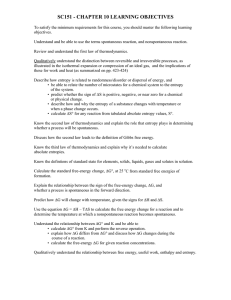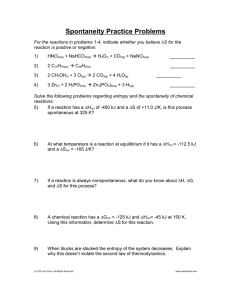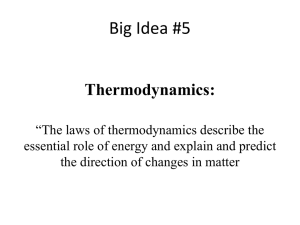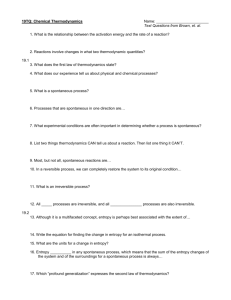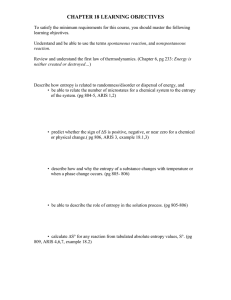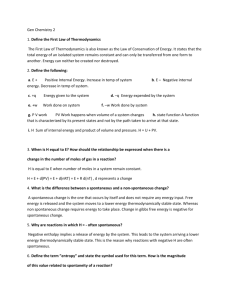Thermodynamics
advertisement
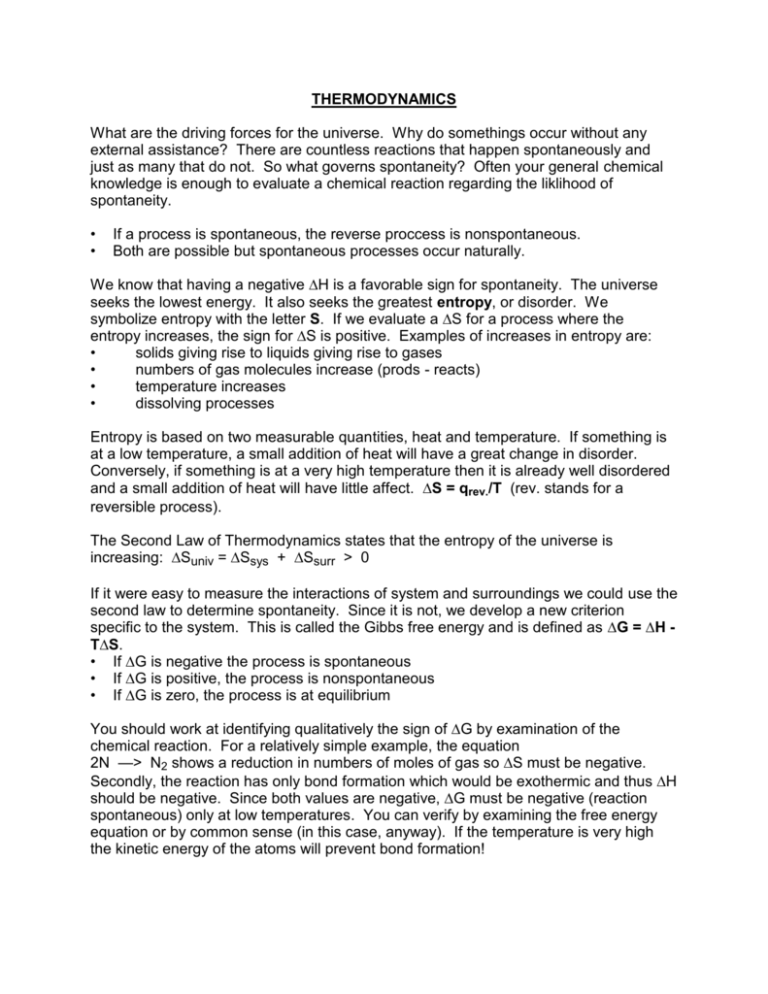
THERMODYNAMICS What are the driving forces for the universe. Why do somethings occur without any external assistance? There are countless reactions that happen spontaneously and just as many that do not. So what governs spontaneity? Often your general chemical knowledge is enough to evaluate a chemical reaction regarding the liklihood of spontaneity. • • If a process is spontaneous, the reverse proccess is nonspontaneous. Both are possible but spontaneous processes occur naturally. We know that having a negative ∆H is a favorable sign for spontaneity. The universe seeks the lowest energy. It also seeks the greatest entropy, or disorder. We symbolize entropy with the letter S. If we evaluate a ∆S for a process where the entropy increases, the sign for ∆S is positive. Examples of increases in entropy are: • solids giving rise to liquids giving rise to gases • numbers of gas molecules increase (prods - reacts) • temperature increases • dissolving processes Entropy is based on two measurable quantities, heat and temperature. If something is at a low temperature, a small addition of heat will have a great change in disorder. Conversely, if something is at a very high temperature then it is already well disordered and a small addition of heat will have little affect. ∆S = qrev./T (rev. stands for a reversible process). The Second Law of Thermodynamics states that the entropy of the universe is increasing: ∆Suniv = ∆Ssys + ∆Ssurr > 0 If it were easy to measure the interactions of system and surroundings we could use the second law to determine spontaneity. Since it is not, we develop a new criterion specific to the system. This is called the Gibbs free energy and is defined as ∆G = ∆H T∆S. • If ∆G is negative the process is spontaneous • If ∆G is positive, the process is nonspontaneous • If ∆G is zero, the process is at equilibrium You should work at identifying qualitatively the sign of ∆G by examination of the chemical reaction. For a relatively simple example, the equation 2N —> N2 shows a reduction in numbers of moles of gas so ∆S must be negative. Secondly, the reaction has only bond formation which would be exothermic and thus ∆H should be negative. Since both values are negative, ∆G must be negative (reaction spontaneous) only at low temperatures. You can verify by examining the free energy equation or by common sense (in this case, anyway). If the temperature is very high the kinetic energy of the atoms will prevent bond formation! Earlier, it was noted that at equilibrium, ∆G is zero. If this is the case, then the free energy equation can be rearranged to: ∆S° = ∆H°/T. If you consider the phase change for liquid water at 100.0°C to water vapor the ∆H is 44.0 kJ and T = 373.15. ∆S = +117.9 J/K. The superscript ° means the transition occured at 1 atmosphere of pressure. For most liquids, the entropy of vaporization is approximately 88 J/mol K. This generalization is known as Trouton's Rule. Since most gases occupy roughly 1000x the liquid volume, the ∆Ss should be comparable. For liquids with strong intermolecular forces (water) the value is too low. For weak intermolecular forces, the 88 J/mol K is too high. Estimate the boiling point of Br2. How does this compare to the accepted value? The Third Law of Thermodynamics states: The entropy of a pure perfect crystal at 0 K is zero. This is related to the quest to establish absolute entropies. Changes in entropy during phase changes can be calculated with ∆S° = ∆H°/T as above. Other entropy changes are derived from how specific heat changes with temperature. Ultimately, the useful outcome is that one can calculate ∆S values from tabulated data in Appendix D. ∆S°rxn = ∑Sprods - ∑Sreact • In general and for qualitative analysis, the more complex the molecules (more atoms) the greater the molar entropies. The standard free energy change is related to enthalpy and thus absolute values cannot be established. But free energy changes can be determined. Like the creation of ∆H°f, we can arbitrarily assign 0 free energy to the elements in their standard states at 1 atm. pressure. We can then find ∆G°rxn = ∑∆G°prods - ∑∆G°react Note that for this relationship, Hess's Law will work, if you reverse a reaction the value of ∆G changes sign, and it is an extensive property. Please also note that this particular equation is good only at 298.15°C! Note that Example 20-6 shows that standard free energy can be calculated two ways.

